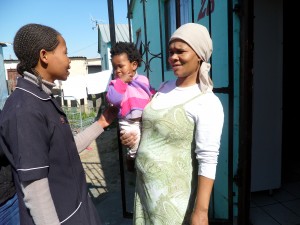Baby Steps taken to reduce Child Mortality
Not far from the beaches and cafés of seaside Cape Town, is the township of Du Noon, where children play in rubbish-strewn streets near pools of stagnant water and lop-sided rows of outdoor toilets.
“They play and eat without washing their hands, so it’s not healthy,” says local health care worker, Nontuthuzelo Debesse, who is paying home visits. “That’s why there’s a lot of diarrhoea, because there’s a lot of dirty water running in the streets.”
 Debesse is one of some 30 women working for about $100 a month to give basic care and advice to families, to prevent illnesses from becoming deadly.
Debesse is one of some 30 women working for about $100 a month to give basic care and advice to families, to prevent illnesses from becoming deadly.
They check to see whether children are immunized, provide medication, and arrange for visits to health clinics and hospitals.
Debesse enters a small shack to see Nortyie Magada, whose 4 year-old daughter has been suffering from diarrhoea, which can be fatal for children when untreated.
Listen to the NPR Report
Unemployed and unable to afford transportation to hospitals, Magada and her husband have come to count on the visits.
“Every day they’re coming, and look for her. They take her to the hospital, and then every time they wash her and put cream on her.”
When children show signs of being unwell, Debesse says most parents don’t know what to do.
“But we as carers we see the symptoms that maybe the child has Tuberculosis or is HIV positive. And we help them take the kids to the clinic, and then we visit every time to see if there is progress.”
In a small office in Du Noon, the carers crowd around Dr. Elbeth Hoffman, who during weekly workshops, trains them to become more effective as an early warning system for families requiring treatment and care.
The women “were not always aware of what it takes to provide children with medication,” says Hoffman. “So now I provide that information, so when they do visit the home, they might be aware of those things and support the parents better.”
Dr. Hoffman’s workshops are supported by the non-governmental organization Kidz positive, (funded in part by USAID). The women work for South African NGO St. John Ambulance. Partnerships of this kind are rare in South Africa, and amount to a drop in the ocean of need for better care.
Since the UN Millennium Development Goals were announced in 2000, some of the world’s poorest countries have managed to reduce child deaths. Not so in South Africa, where mortality rates are back where they were in 1990. For every pool of 1,000 children in the population, 62 children die before their fifth birthday. That number has failed to fall because of malnutrition, unsanitary conditions, and HIV–AIDS. (The average for Sub-Saharan Africa is 144, compared to just 4 or 5 in Europe.)
South Africa’s health care system was in the spotlight last year when six newborn babies were found dead in a Johannesburg hospital in one day. A health department investigation revealed the hospital was unhygienic, ill-equipped and understaffed.
Poor children fare the worst.
They often live far from a hospital or health clinic, and are unable to afford the transportation costs to travel to one.
To buttress a beleaguered national health service, more local health clinics are being built – including one expected in Du Noon by 2014. In the mean time, specialists say grass-roots care must be scaled up.
“That means community health workers in much larger numbers than there are now, and equipped with a broader set of skills,” says David Sanders, a paediatrician and Professor of Public Health at the University of the Western Cape.
Continuing her home visits, Nontuthuzelo Debesse pops in to see Pamella Detsele, who has been living with HIV/AIDS for eight years. Until Debesse and her colleagues began their visits last year, Detsele often forgot to take her medication. Now she receives a daily reminder by text message at 7am and 7pm.
Her health has improved dramatically: her CD4 count – a type of blood cell indicating the strength of the body’s immune system – has risen from 74 to 900.
Detsele’s husband died from AIDS eight years ago. A decade before that, her eight month-old son was suffering from frequent bouts of diarrhoea. During a severe episode one evening they rushed to hospital, but it was too late. Detsele says spotting the symptoms earlier may have saved the baby’s life.
“Maybe he could survive if it was this time now,” she says, pointing to the care workers making lunch in her kitchen.
While this kind of care is rare in South Africa, it’s bearing fruit in South Asia.
Recent studies in India have shown that women’s groups providing home-care support and health education have helped bring about significant reductions in infant mortality, cutting it by a third in the first year of the survey. That figure rises to 45% in years two and three.
With improved access to healthcare, the prognosis for the United Nations Millennium Development Goals might not be so bleak. Of the 68 countries aiming to achieve MDG 4 – reducing mortality rates in children under five between 1990 and 2015 – only 19 are on track.
But 17 countries have cut mortality rates by more than half.



